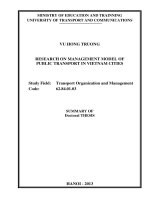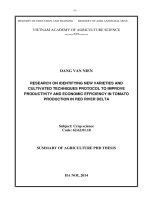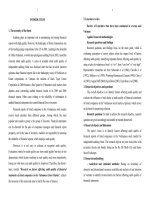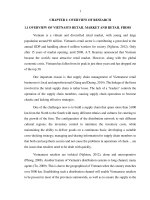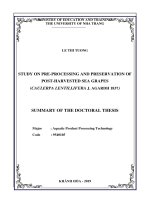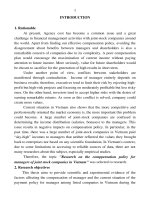Summary of biologicaldoctoral thesis: Research on species, distribution and intoxicant of Amanitaceae R.Heim ex Pouzar in Highland
Bạn đang xem bản rút gọn của tài liệu. Xem và tải ngay bản đầy đủ của tài liệu tại đây (731.81 KB, 27 trang )
MINISTRY OF EDUCATION
VIETNAM ACADEMY
AND TRAINING
OF SCIENCE AND
TECHNOLOGY
GRADUATE UNIVERSITY SCIENCE AND TECHNOLOGY
---------------------------Name Ph.D Tran Thi Thu Hien
RESEARCH ON SPECIES, DISTRIBUTION AND INTOXICANT
OF AMANITACEAE R.HEIM EX POUZAR IN HIGHLAND
MAJOR: Botany
Code: 9 42 01 11
SUMMARY OF BIOLOGICALDOCTORAL THESIS
HA NOI - 2018
This thesis was fulfilled at Graduate University of Science and
Technology, VietNam
Scientific instructor 1: Assoc. Prof. Dr. Tran Huy Thai
Scientific instructor 2: Assoc. Prof. Dr. Le Ba Dung
Reviewer 1: Prof. Dr. Pham Quang Thu
Reviewer 2: Assoc. Prof. Dr. Tran The Bach
Reviewer 3: Ph.D. Ha Minh Tam
The thesis will be defended in the Graduate University of Science and
Technology (GUST) council at Vietnam Academy of Science and
Technology (VAST) at …… on….. 2018
This thesis may be found at:
- The library of GUST
- National Library of Vietnam
INTRODUCTION
1. Significance of the research
Fungi were a saprophyte in the ecological enviroment. They could
extract enzyme to the enviroment to resolute complex molecules into
simple substances. Thus they play the important role into improve the
natural cycle of material circulation, mineralization of organic compounds,
freshing the ecological environment, increasing the fertility of the soil, so
increase crops and forest trees productivity.
The ecosystem in the Central Highlands is diverse with six main
ecosystem types, including tropical evergreen closed forest, deciduous
subtropical wet forest, deciduous semi-evergreen tropical forest, coniferous
mixed bamboo forest, grass and shrub, residential areas. Flora and founain
this area is very abundant, has many rare and precious species in Red Data
Book of Vietnam.
Nature condition in Central Highlands is convenient to
development of Fungi and Amanita genus. The research on large fungi is
very little, concentrated on midland area. In the Central highlands, there are
some research in South of Central highlands, the other areas almost has not
researched. Amanitaceae play the important role in the Fungi as a
diversities and special in poison, theses Fungi are highly toxic and easily
confused with some edible fungus.
The habit of using mushrooms in the wild and from the forest as
food is quite common to the people in the locality. This areas was
difficulties economic areas, living standard of the people is very low, most
of them are poor and dependent forest. Thus forest is a sources to provide a
food for living, among them mushroom is a the food that people say is a
specialty. Wild mushrooms was delicious and aromatic with very high
nutrients food. But it is also unfortunate confusion between the poisonous
mushrooms and edible mushrooms.
1
In the nature, there are alot of poisonous mushroom belong too
other genus susch: Amanita, Galerina, Lepiota, inobybe, Agaricus… eg:
The genus Amanita have Amanita verna, Amanita virosa, Amanita
phalloides… should be a confusion for people when using wild mushrooms
as food, in fact, there have been many cases of lethal fungal poisoning due
to lack of knowledge about poisonous mushrooms.
Inoder to provide the knowledge to the people who understand and
distinguish between the poisonous mushrooms and edible mushrooms is
very necessary. Thus, I have chosen the topic
“Research on species, distribution and intoxicant of Amanitaceae
R.Heim ex Pouzar in Highland”.
2. Research Objectives
- Identify some biological, ecological characterisitics of
Amanitaceae in Highland.
- Analyze intoxicant of some species in Amanita genus.
3. Scientific significance of the research
- Research on biological, ecological characterisitics Amanita genus.
- Supplement large mushroom list particulary in Highland and
Vietnam in general, simultaneously provide data basic for the other research
fields.
4. Practical significance of the research
Identify the poisonous mushrooms in the nature to prevent fungal
poisoning.
5. New result of the research
It is the first time to have a research on Amanitaceae, establish the
list of species of Amanitaceae in Highland. Identify the scienctific name of
23 species among 33 species and uses molecular biology to identify 16
species of this family in the Central Highlands. Introduce 15 species as a
new record for large fungi list of Vietnam and 8 species could be a new
species.
2
Research on biological, ecological characterisitics Amanita genus
- Establish the multivariate regression equation to focast the
distribution of Amanita species was Tansoxuathien = C + a*l + b*m +
c*h - d*t
- Determined the intoxicant of Amanita sp.1 to causing death of
experiment animal by oral with LD50 was 4750 mg/kg weight.
6. Chapter layout of thesis
This thesis is including 159 pages, 12 tables, 37 figures, 1 map and
index.
The sections of the thesis were: Index, list of tables, list of figures,
list of abbreviations, list of charts.
Introduction (5 pages); Chapter 1: Overview of publications (30
pages); Chapter 2: Subject, location, content and research methods (23
pages); Chapter 3: Research results (90 pages); Conclustion and
recommend (2 pages); List of published by the author related to the thesis
(2 pages); Refefences (8 pages); Index.
CHAPTER 1. OVERVIEW OF PUBLICATIONS
1.1. Fungi classification system
1.1.1. History of Fungi taxonomy
1.1.2. Basidiomycete and taxonomy system
1.1.3. Trinh Tam Kiet system
Div. Basidiomycota R. T. Moore (1980)
Fam. Amanitaceae R.Heinn ex Puozar (1983): 3 genus (+23
syns)
Characteristic: Fruit body is fleshy, easy to putrid. Cap is
umbrella shape, stalk central attached, easy to separate. Spore
radiation produce in the gill. Gill free. Spores glabrescent, no colour
in the microscope, pink when concentrated. Young fruit body has cover
by two membrance, scar when adult.
* Gen. Amanita Pers. (1987): Large distriobution, many species
3
were rooting mushrooms, some saprophyte.
Characteristic of Amanita genus:
- Many colours like: red, orange, yellow...
- Cap fleshy, umbrella shape
- Gill large, white or yellow...
- Stalk fleshy, central attached, easy separate.
- Spore no colour, globose to elippsoidal, glabrescen.
- Saprophyte on land.
- When the fruit body is immature, young body volva and skirt
connect from cap margin to stalk. Then tear to ring and volva – these are
particular characteristic of Amanita genus.
* Gen Limacella Murrill (1911): including 3 species
* Gen. Catatrama Franco-Mol. 1991: inculuding 02 species
According to Trinh Tam Kiet, Le Ba Dung, Ngo Anh, Le Van
Lieu there are 37 species (among them 33 species was identified and
04 species was not identified) in Amanitaceae family, 12 species has
been described.
1.1.4. Fungal poisoning from Amanitaceae situation
Mycetism was a toxic effects from eating the intoxicant in the
mushroom. The symptoms are from disorders digestive to death. The
toxins contained are secondary metabolites produced by the distinct
biochemical in the fungi cell. Mushroom poisoning was a result by eating
wild mushroom which not exactly identify. Mushroom poisoning
sometimes happened with experience mushroom picker.
Vietnam was a country which had abundant biodiversity in the wold.
Recently, there are 3000 fungi species had been recorded in Vietnam in which
1800 species lare fungi, among them there are 50 species has intoxicant.
Most of the poision mushroom was not lethal poision mushroom, but
the lethal poision mushroom almost was Amanitaceae such as Amanita
phalloides, Amanita virosa, Amanita verna. Amanita species are confusing to
4
other mushroom species, specially when young, boddy ovoid has volve is
similar to Volvariella esculenta, Volvariella bombycina or other species
Bovista, Lycoperdon….
CHAPTER 2
SUBJECT, LOCATION, CONTENT AND RESEARCH METHODS
2.1. Subject, location, content and research methods
2.1.1. Subject
Amanitaceae species has distribution in the Highland.
2.1.2. Material
- Olympus microscope (Japan), Olympus magnifying glass (Japan),
colour table, KOH liquid…
- Tools:
+ In the field: Chisel, knives, plastic bags, cameras …
+ On tha laboratory: the pick, razor, lamen, …
+ Needle, eppendof, aseptic water, analysis scale and other
chemistries, some of molecular chemistries of Sigma, Merck,...CTAB, Tris
base, acid Boric , NaCl, dNTPs, EDTA, 6X orange loading dye solution, Taq
Polymeraza, Ethanol, 2-propanol, Acetic acid glacial, Phenol, Chloroform,
isoamyalcohol, Agarose and ITS primer.
Animal: BALB/c thoroughbred mouse was healthy in animal shelter
of Institute of Biotechnology, Vietnam Academy of Science and
Technology. Mouse has feed by standard food and free water.
ITS primer list (White et al. 1989)
No
ITS1
Mồi
ITS4
Nucleotide sequence
TCCGTAGGTGAACCTGCGG
TCCTCCGCTTATTGATATGC
5
2.1.3. Location
Highland area (Chu Yang Sin National park, Yok Don National
park, Ea Sô Nature conserve, Bidoup Núi Bà National Park, Chư Mom Ray
National park, Kon Ka Kinh National park).
2.2. Contents
- Investigate and collect the specimen of Amanataceae in the
Highland.
- Analyse biological, ecological characteristic of Amanitaceae
collected species in Highland.
- Identify the species of specimen was collectd and establish the
List of Amanataceae species in Highland.
- Analyse intoxic of one species of Amanataceae family.
2.3. Research Methodology
2.3.1. Collecting method for fungi in the Field work
- Collect Amanataceae specimen by line survey that go through the
different representations (broadleaved forest, coniferous forest, mixed
forest...) in Highland.
- The time to collect specimen: in rainy season (from June to
November)
The specimen was collected base on main characteristic of
Amanitaceae family.
2.3.2. Processing and preservation specimen method
Specimen was preserve in air and cool place. Change the cover
when wet or dirty. Describe the characteristic of species on the field book
such: size, colour, cap surface, merge characteristic, spore, stalk, gill, ….the
species was not identified or have enough standard sould be soaked.
6
2.3.3. Specimen analyze method
2.3.3.1. Morphology
2.3.3.2. Microscopic characteristics
2.3.4. Identify
2.3.4.1 Comparative morphologic method
Base on document of Trinh Tam Kiet (2012,2013), Le Ba Dung
(2003), Teng (1964), Singer R.(1986), Jiri Baier (1991), Denis R. Benjamin
(1995)
2.3.4.2. Moleculare identifying method
Some of the species had similar characteristic, thus we use
moleculare indentifying method to analyze the distent between them.
2.3.5. Toxicity test method
Toxicity test method is to Confirm the toxicity at different doses of
the test substance when tested on animals. Animalswas divided to other
goups, in which group animals has one dose, and increase the dose from
one group to another. Note the death animals in the group, the dose and
number of death animals in the group is an important parameter in Toxicity
test method DoTrung Dam, Dodehe Yeo et al. (2012), N’dia Kouadio
Frédéri et al. (2013), Aristide Traore et al. (2014).
2.3.6. Determined ecological factors method
Determined ecological factors method (temperature, humidity, light,
altitude) by using Tiger Direct HMAMT-110 (USA), TigerDirect
LMLX1010B (USA), GPS Garmine Trex Vista HCx (USA).
2.3.7. Analyze the interrelation of ecological factors method
MS TAT 2009 and Excel software used for statistical processing.
Statgraphic Centurion XV software to to establish multivariate
regression and to analyze the relationship of density, frequency of
occurrence of species Mushrooms with ecological factors
7
CHAPTER 3
RESULT AND DISCCUSION
3.1. Amanitaceae R.Heinn ex Puzar (1983) morphology
Fam. Amanitaceae R.Heinn ex Puozar (1983): 2 genera.
Fruit body fleshy, easy to putrid. Cap is umbrella shape, stalk
central attached, easy to separate. Spore radiation produce in the gill.
Gill free ,Spores glabrescent, no colour in the microscope, pink when
concentrated. Young fruit body has cover by two membrances, scar
when adult.
Gen. Amanita Dill. ex Boehm. 1760
Including the most poision mushroom distribution in hold the world.
Characteristic:
- Many colour like: red, orange, yellow...
- Cap fleshy, umbrella shape
- Gill large, white or yellow...
- Stalk fleshy, central attached, easy separate.
- Spore no colour, globose to elippsoidal, glabrescen.
- Spore from 5-7 x 10-12 µm
- Saprophyte on land.
- Hole 20 - 300
- Young body Volva and skirt connect from cap margin to stalk.
Then tear to ring and volva – these are particular characteristic of Amanita
genus.
Gen. Limacella Murrill 1911: 03 species rarely distribute in Asia.
Gen. Catatrama Franco-Mol. 1991: there are 02 species in the
world.
3.2. Amanitaceae species list in Highland
This thesis was investigated, described, identified and established
25 species of Amanita, Amanitaceae (table 3.1).
8
Table 3.1: Amanitaceae species list in Highland
No
Habitat
R
RHG
B
LK&L
T
R
X
Science name
R
T
1
Amanita caesarea
Gillet 1874
++
+
+
++
2
Amanita caesareoides
Lj.N. Vassiljeva 1950
+
++
+++
new record
++
+
+
++
new record
++
new record
3
4
5
6
7
8
9
10
11
12
13
Amanita crocea Quél.
Singer 1951
Amanita eliae Quél.
1872
Amanita excelsa Fr.
Bertill. 1866
Amanita flavoconia
G.F. Atk. 1902
Amanita fulva Fr. 1815
Amanita
multisquamosa Peck
1901
Amanita pantherina
D.T. Jenkins 1977
Amanita phalloides
(Fr.) Secr. 1833
Amanita pilosella
Corner & Bas 1962
Amanita similis
Boedijn 1951
Amanita spreta Peck&
acc 1887
14
Amanita sp1.
15
Amanita sp2.
16
Amanita sp3.
17
Amanita sp4.
18
19
Amanita sp5.
Amanita sp6.
20
Amanita sp7. (DL274)
21
Amanita sp8. (DL89)
R
T
X
++
TC,
CB
+
++
+
++
++
++
+
+
++
++
+
new record
++
+
+
Note
+
+
+
+
+
++
++
+
+
++
+
+
++
+
++
+
++
++
++
+
+
+
++
new record
++
new record
++
++
++
++
+
+
++
+
++
9
+
+++
+++
++
+
++
+
+
+
22
23
24
25
Amanita sp9. (DH048)
Amanita sp10.
(DL001)
Amanita sp11.
(DL127)
Amanita sp12.
(DL019)
+
++
+
+
+
++
+
+
+
+
+
+
++
+++
+
(RT: Pinus forest; RTX: evergreen forest; RBTX: Semi-evergreen fores;
RHGLK&LR: needles and broad leaves mixed; TC, CB: grass and brush)
Note:
+: Species scare
++: Species abudant
+++: Species verry audant
10
(V)
Chu Mon Ray
NP (Kon Tum):
14°18′ - 14°38′
N, 107°29′ 107°47′ E
(IV)
KonKa Kinh NP
(Gia
Lai): 14°09′ 14°30′ N;
108°16′ 108°28′ E
(II)
Yok Don NP:
12°45′ - 13°10′
N; 107°29′30″ 107°48′30″ E
(III)
Chu Yang Sin
NP:
120°14′16″ 130°30′58″ N;
108°17′47″ 108°34′48″ E
(I)
(VI)
Bidoup Núi Bà
NP: 12°00'00" 12°30'00" N;
108°35'00" 108°75'00" E
Ea sô NC:
12O53’18” 13O02’12” N;
108O28’48” 108O43’54” E.
Map of collection Amanitaceae speciemen in Central Highlands
3.3. Key to species of genus Amanita
1. Stalk complete, volva receptacle ...................................................... 2
1. Stalk complete, volva not receptacle ................................................ 3
2. Stalk collar shape ............................................................................ 11
2. Stalk not nectar shape ..................................................................... 12
3. Volva bulb shape, stalk ring .......................................................... 4
3. Volva bulb shape, stalk not ring .................................................... 5
4. Cap and stalk dark yellow to ferruginous, ring collar shape connect to 1/3
stalk above. Spore 5-7 x 8-10 µm .......... Amanita flavoconia.
4. Cap and stalk dirty white, minute scales in surface, ring connect 1/3 stalk
basal. Spore 6-8 x 8-10 µ .......................... Amanita concentrica.
11
5. Stalk withou scales........................................................................ 6
5. Stalk scales, cap verrucose smaller than 2 cm ......................................... 7
6. Cap verucose saller 2 cm ............................................................................... 8
6. Cap verucosecó larger than 2 cm .................................................................. 9
7. Cap light brown, spore smaller 9 μm, verucose sparse, concentrate in a
central, spore oblong- ellipsoid, 5-6×7-9 μm, endorsperm yellow...Amanita
excelsa.
7. Spore larger than 9 μm ................................................................... 10
8. Cap flat, slightly concave. Ring stalk distintc; Spore globose, 7-9 x 10-12
µm, endorsperm seed oil of floating ......... Amanita pilosella.
8. Cap tan colour, stalk cylindiric,light whight, fiber system crystal, baffled,
ring stalk indistintc, spore 5-8 x 9-12 µmAmanita multisquamosa.
8. Cap dark brown, rings on the central of stalk, surface mucusly, spore 6-8
x 8-10 µm .............................................................Amanita pantherina.
9. Cap convex, white, around the cap have folds, fiber system light yellow, wall,
spore 6-8 x 9-12 µm, endorsperm green seedsAmanita hesleri.
9. Cap umbrella shape, white, scaly white; Stalk white, ring distinct. Fiber
system crystal, whithout wall, spore 8 - 10m in diameter, endorsperm green
without seeds ................................................... Amanita cokeri.
10. Verucose denserly on cap surface, spot many colour: from white to
black, ring collar shape distinct, spore 6-9 x 8-11 µm, endorsperm seed oil
of floating .................................................... Amanita sp.DL274.
10. Verucose denserly on cap surface, white; Stalk bulge in the middle,
Spore 7-9 x 8-12 µm, endorsperm seed oil .Amanita abrupta.
10. Verucose sparse, spore thick, globose, 6-8 x 9-11 µm, endorsperm
yellow to green seeds, Cap light grey-brownAmanita sp. DL89
11. Cap capanulate, light grey to brown-grey, stalk cylindric, ring white,
scar shape. Spore 6-8 x 8-10 µm. Fiber system without wallAmanita
Phalloides.
11. Cap smooth, orange yellow ..................................................... 14
11. Cap is not smooths................................................................... 13
12. Fruit body conical .................................................................... 16
12. Fruit body capanulate .............................................................. 17
12. Fruit body umbrella shape ....................................................... 18
13. Cap umbrella shape, white verucose on cap surface, spore elipsoid
starch granules, 4-6 x 8-10 µm. Pore with pink colour, ring closed to cap,
fiber system without wall (4-6µm in diameter) ........Amanita Sp.1
13. Stype cream white ................................................................ 15
12
14. Cap umbrella shape, yellow on the top. Spore yellow, without
endorsperm, 5-7 x 9-12 µm, fiber system without wall .Amanita cacsarea.
14. Cap umbrella shape, yellow on the top; stalk ligh yellow or scream
white; Spore has yellow endorsperm, 5-7 x 8-10 µm; fiber system has wall
..................................................................... Amanita Levistriata
15. Cap umbrella shape, cream white, brown verucose on cap surface,
central of cap brown yelow, ring ¼ from top of stalk, stype slabs free, gill
not equal, closed, cream white; fiber system without wall, spore elipsoid, 67 x 10-13 µm ..................................................... Amanita sp.2
15. Cap umbrella shape, dark greyin the centre, from centre to the edge
scattered grey spot; Ring cream white, stype slabes cream white, ring from
1
/2 of stalk, spore ellipsoid, 5-7 x 9-12 µm......Amanita Sp CĐ 279.
15. Cap umbrella shape, white to light pink, spore ellipsoid, endorsperm
green seed, 5,4-7 x 9-11µm, fiber system has wallAmanita Eliae
16. Cap 2 parts distinct: outer dark brown have rough, inner white without
rough, spore ellipsoid, endorsperm yellow seed oil, 8,2-10,5 x 6-8µm, fiber
system crystal, wall, 3-4 µm ............................ Amanita fulva
16. Cap unicolour ................................................................19
17. Cap yellow brown, Stalk scabrous, many small scale, spore ellipsoid has
endorsperm, Spore 6-8 x 9-12µm .......... .........Amanita Sp.DH048
17. Spore geometry ............................................................................. 21
18. Cap merge radiation have roughs ................................................. 22
18. Cap merge not radiation without rough of rays ............................ 23
19. Cap light brown, spore globes, green, endorsperm oil seed. Spore 5,5-7
x 8-9µm ...................................................................................
........................................................................ Calyptroderma
19. Spore ellipsoid ........................................................................... 20
20. Cap light honey yellow, spore ellipsoid, endorsperm light green oil
seeds, 6,5-7,5 x 10-12,8µm.....................................Amanita sp.DL 127
20. Cap dirty white, scabrous, merge are closely packed. Spore ellipsoid, 79x 10-12µm, endorsperm seed oil .......... Amanita Sp.DL 001
21. Cap red, smooth, Stalk yellow, merge deep. Spore globose, endorsperm
oil seeds, 6-7 x 8-9µm, fiber system crystal (3-4 µm), wallAmanita
caesareoides
21. Cap dirty white in centre, merge folds, spore globose, 7.5-8 x 9-10µm,
without endorsperm, hệ fiber system light yellow, without wall Amanita
punctata
13
22. Cap dirty white, centre light yellow, slightly concave, spore globose,
glabrescen, without endorsperm (8-12 µm in diameter), fiber system has
wall, branched (2,2-4 µm) ................................... Amanita Sp.PR 421
22. Spore ellisoid ............................................................................. 24
23. Cap brown, white scales, Stalk from white to brown; spore oval or
obvoid (6-8 x 8-10µm), endorsperm green hạt dầu, fiber system branhed,
has wall (3-4 µm).......................................... Amanita Pachycolea
23. Spore ellisoid ........................................................................ 26
24. Cap yellow, centre dark yellow, Stalk straw yellow, deep concave,
scabrous, spore ellipsoid, endorsperm brown seed oil, 6-8 x 10-12µm, fiber
system without wall, 5-6 µm
.............................................................................. Amanita similis
24. Fiber system branched .......................................................... 25
25. Cap grey brown, centre dark grey, spore ellisoid, endorsperm light
yellow, 5-7x 10-12µm, fiber system branched. Amanita battarrae
25. Cap cream, centre light brown, spore ellipsoid, endorsperm seed oil, 6-8
x 8-10µm, fiber system light yellow, branched, has wall Amanitas spreta
26. Cap yellow, central orange lighter than merge, Stalk yellow, yellow
scales, Spore ellipsoid, 7,5- 8 x 8-10 µm, endorsperm seed oil, fiber system
has wall ................................................................ Amanita Crocea
26. Fiber system not branched .................................................... 27
27. Cap umbrella shae, flatt or slightly concave in the centre, white to
cream yellow, spore 2,3 – 3,5 x 4- 6µm, has endosperm, fiber system not
branched ..........................................................Amanita Sp.DL019
27. Cap cream yellow, centre concave, darker, Stalk cream. Spore ellipsoid,
5-7x 9-11µm, endorsperm seed oil, fiber system crystal, not branched (4-6
µm) ........................................................ ......Amanita amanitoides
3.4. Describe the species in Amanita genera in Highland
3.5. Effect of ecological factors on the distribution of Amanita
3.5.1. Effect of temperature on the distribution of Amanita
14
From the result, we found that temperature was a ecologica factor
has effec to the appearance of Amanita species. In a temperature as 19220C, frequency appears has dominated, take 68% from all the temperature
levels, take 24% from the lower 190C and 8% from 220C.
3.5.2. Effect of humidity on the distribution of Amanita
Base on the percentage of Amanita species from the figure, show
that humidity could impact on the appearance of Amanita species. In 8590% humidity, frequency appears take 78%, this humidity is the best for
grow and development of Amanita. In more than 90% humidity and less
than 85% frequency appears take 5%, 17%. This becaused of in less than
90% humidity with temperature more than 22 0C is not a otimal condition
15
for grow and development of Amanita. In more than 90% humidity, the
water in the cell inconvenient to decay and gowth of fiber system.
In more than 90% humidity and less than 85% is inconvenient to
development of Amanita species, thus frequency appears is low. Central
Highlands has 85-90% humidity, so this area has convenient condition to
the development of Amanita.
16
3.4.3. Effect of altitude on the distribution of Amanita
From the result of research, altitude effect to frequency appears of
Amanita species show that from 200 to more than1100m from sea level,
altitude effect has descending by evelation. In 500 - 800m frequency
appears take 74%, then 17% in 200 - 500m, faster descending follow 7% in
in 800-1100m to 2% in 1100m.
This is explained by in morer than 800m from sea level, vapor is
higher, oxygen content is lower cause to humidity in the air is to 95-100%,
this condition is inconvenient for development of Amanita. Thus in 500-800
m e altitude is the convenient for development of Amanita .
17
3.5.4. Effect of light indensity on the distribution of Amanita
The result of research shows that the light has been efected to the
appearance of fruit body of Amanita. Amanita species in Highland has
distributed in area which has light less than 8000 -10000 lux (take 66%),
22% in 8000 lux and 6% in more than 10000 lux. The fruit body
developmet of Amanita the best in 8000-10000 lux. Thus, this result also
consistent with the investigation in the field, Amanita species appear in
coniferous forest an scattered forest.
3.5.5. Effect of habitat on the distribution of Amanita
18
The result of research shows that habitat has been efected to the
appearance of fruit body of Amanita. Amanita species distribute almost in
coniferous forest, mixed forest, grass and shrub.
3.5.6. Model predicts multivariable regression to forecast the frequency
of occurrence (density) of species based on ecological factors
(temperature, humidity, altitude and light intensity)
Data base from 99 investigated points synthetic in Excel programme,
using Statgraphic Centurion XV software to set of multivariate regression
and analysis relationship, frequency of occurrence of Amanita species whith
the ecological factors. Data base of 99 investigated points of species,
multivariate regression with 5 ecological factors, the variables that have not
satisfied the condition of relationship with frequency of Amanita species
occurrence was excluded in P > 0,05.
Detecting relationships from simple to complex functions, from single
to combinations variable, the results of the establised multivariate
regression for the mushroom species are as follows:
Table 3.7. The value of the multivariate regression equation
Parameters
a
Anhsang
Doam
Docao
Nhietdo
Value
Error
T
-1.98314
6.81899 -0.290825
0.00207615 0.000191312 10.8521
0.283289
0.0470994 6.01471
0.00764196 0.00112211 6.81033
-0.298556
0.134036 -2.22744
P-value
0.7718
0.0000
0.0000
0.0000
0.0281
With 05 ecological factor variables, 04 factors has importance effect to
the Amanita species frequency of occurrence, follows:
Tansoxuathien = C + a*l + b*m + c*h - d*t
(C, a,b,d were
constant)
With n = 99 and all the variables has been checked by t condition as P
< 0,05; shows that light intensity (l), air humidity (m), altitude (h) and air
temperature (t), has importance effect to the dentity and Amanita species
frequency of occurrence. At the same time, with R2 = 72.7894% and P <
0,05 the relationship of frequency of occurrence and 4 ecological factors is
19
very tight, and interacting with each other as follows: The frequency is
inversely proportional to the temperature, which suggests that as the
temperature rises it will reduce the Amanita species frequency of
occurrence. The Amanita species frequency of occurrence is proportional to
the relative humidity, light intensity and altitude, which means that when
the higher the air temperature decreases, the air humidity increases, the
number of mushroom species appears to increase.
This model help for understanding of ecological request of Amanita
species, provide data base for find out the Amanita species distribution
areas and species’s planting and growing.
3.6. The result of intoxic research of Amanita sp.1
3.6.1. The result of intoxic research of Amanita sp.1 by oral.
With the experimental layout above, the result was in 3.8 table.
Table 3.8. Number of death mouse, external appearance of mice when
drinking
Lot
Sample
(mg/kgP)
The
numbe
r of
death
mouse
among
72
hours
(indivi
dual)
The number of
death mouse
after 72 hours
(individual)
1
3500
0
0
2
4000
2
0
3
4500
4
1 (after 8 days)
20
External appearance mouse
among 0-72 hours
After 8 hours from drinkin,
mouse
move
and
eat
normally, after 24-72 hours
mouse has increased nerve
impulsivity, reduced diet.
After 8 hours from drinkin,
mouse
move
and
eat
normally, after 24-72 hours
mouse has increased nerve
impulsivity, reduced diet.
After 8 hours from drinkin,
mouse
move
and
eat
normally, after 24-72 hours
4
5000
6
2 (after 7 days)
5
5500
8
2 (after 5 days)
6
6000
10
7
7000
10
21
mouse has increased nerve
impulsivity, reduced diet,
some individuals have eyes
protruding.
After 8 hours from drinkin,
mouse
move
and
eat
normally, after 24-72 hours
mouse has increased nerve
impulsivity, reduced diet,
some individuals have eyes
protruding.
The
diet
individuals
have
been
weekens and dead.
After 8 hours from drinkin,
mouse
move
and
eat
normally, after 24-72 hours
mouse has increased nerve
impulsivity,
diet,
eyes
protruding.
After 8 hours from drinkin,
mouse
move
and
eat
normally, after 24-72 hours
mouse has increased nerve
impulsivity,
diet,
eyes
protruding.
After 8 hours from drinkin,
mouse
move
and
eat
normally, after 24-72 hours
mouse has increased nerve
impulsivity,
diet,
eyes
protruding.
Dose
(mg/kgP)
3500
4000
4500
5000
5500
6000
Table 3.9. Data synthesized
The
N
a
b
number of
(mg)
death
mouse
among 72
hours
(individual)
0
10
2
10
500
1
4
10
500
3
6
10
500
5
8
10
500
7
10
10
500
9
Σa×b/N
a×b
500
1500
2500
3500
4500
a×b/
N
(mg)
50
150
250
350
450
1250
Dose of 7000mg causing death of 100% animals, however, the new
dose of 6000mg is the lowest dose causing death of 100% animal, thses dose
is a basis for calculating the lethal dose was caused of 50% of the
experimental animals. Thus the data of 7000 mg dose was ignore.
N (number of individuals in sample): 10 (individuals/sample)
a: Distance from 2 consecutive doses was: 500 mg
b: Average mortality of two consecutive groups
Base on result from table 3.9, has been determined LD50 (the dose
was caused of 50% of the experimental animals death).
LD50 value such follows:
= LD100 - Σa×b/N
= 6000 – 1250
= 4750
The result shows that: The mushroom sample was caused animal
death by oral with the 50% death dose LD50 = 4750 mg/kg
LD50
LD50
LD50
22
CONCLUSION AND RECOMMEND
1. Conclusion
1. This research was recorded that in the Central Highlands there
are only genus Amanita of Amanitaceae family. 913 have been collected
and identified by comparative morphologic method and moleculare
identifying method, 25 species was identified, among them: 13 species has
been identified science mame and 12 species determined as Amanita spp..
2. 13 species included 6 species was a new record for Vientmam,
such as: Nam
A. caesareoides, A. crocea, A. flavoconia, A.
multisquamosa, A. pilosella, A. Similis.
3. Inculding 12 species determined as Amanita spp. There are 6
species have been research on nucleotide sequences.They sould be a
new species.
4. Identify convenient ecological factors of development of
Amanita species as follows: temperature: 19-22 0C, humidity: 85-90%,
altitude: 500-800 m and and light intensity: 8000 -10000 lux.
5. Establish the multivariable regression prediction model to forcast
the frequency of occurrence of Amanita species was Tansoxuathien = C +
a*l + b*m + c*h - d*t
6. Analyze intoxic of Amanita sp1, dose was caused animal death
by oral with the 50% death is LD50 = 4750 mg/kg.
2. Recomend
- Extensive research on the diversity of mushroom Amanitaceae
families.
- Research detail on active ingredients in mushrooms for use in the
field of medicine.
- Protect the living enviroment of fungy and forest.
LIST OF PUBLISHED BY THE AUTHOR RELATED TO THE
THESIS
23

